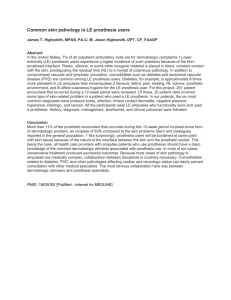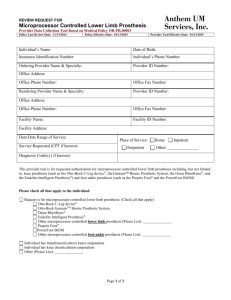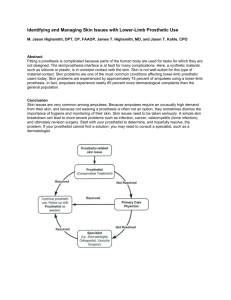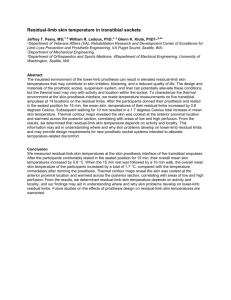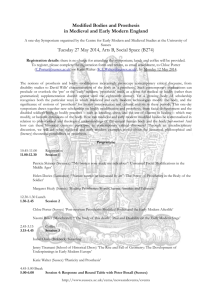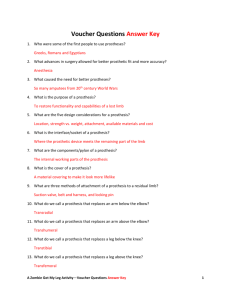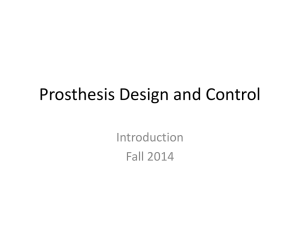The Biomechanics of the Canadian-Type Hip
advertisement
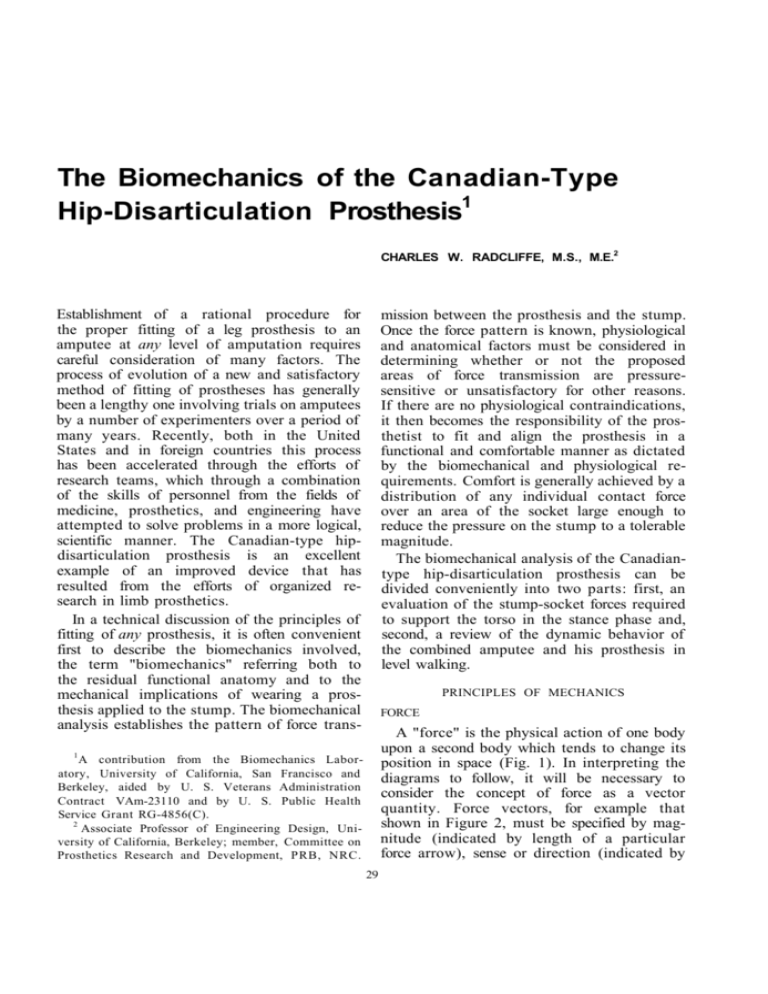
The Biomechanics of the Canadian-Type Hip-Disarticulation Prosthesis1 CHARLES W. RADCLIFFE, M.S., M.E.2 Establishment of a rational procedure for the proper fitting of a leg prosthesis to an amputee at any level of amputation requires careful consideration of many factors. The process of evolution of a new and satisfactory method of fitting of prostheses has generally been a lengthy one involving trials on amputees by a number of experimenters over a period of many years. Recently, both in the United States and in foreign countries this process has been accelerated through the efforts of research teams, which through a combination of the skills of personnel from the fields of medicine, prosthetics, and engineering have attempted to solve problems in a more logical, scientific manner. The Canadian-type hipdisarticulation prosthesis is an excellent example of an improved device that has resulted from the efforts of organized research in limb prosthetics. In a technical discussion of the principles of fitting of any prosthesis, it is often convenient first to describe the biomechanics involved, the term "biomechanics" referring both to the residual functional anatomy and to the mechanical implications of wearing a prosthesis applied to the stump. The biomechanical analysis establishes the pattern of force trans- mission between the prosthesis and the stump. Once the force pattern is known, physiological and anatomical factors must be considered in determining whether or not the proposed areas of force transmission are pressuresensitive or unsatisfactory for other reasons. If there are no physiological contraindications, it then becomes the responsibility of the prosthetist to fit and align the prosthesis in a functional and comfortable manner as dictated by the biomechanical and physiological requirements. Comfort is generally achieved by a distribution of any individual contact force over an area of the socket large enough to reduce the pressure on the stump to a tolerable magnitude. The biomechanical analysis of the Canadiantype hip-disarticulation prosthesis can be divided conveniently into two parts: first, an evaluation of the stump-socket forces required to support the torso in the stance phase and, second, a review of the dynamic behavior of the combined amputee and his prosthesis in level walking. PRINCIPLES OF MECHANICS FORCE A "force" is the physical action of one body upon a second body which tends to change its position in space (Fig. 1). In interpreting the diagrams to follow, it will be necessary to consider the concept of force as a vector quantity. Force vectors, for example that shown in Figure 2, must be specified by magnitude (indicated by length of a particular force arrow), sense or direction (indicated by 1 A contribution from the Biomechanics Laboratory, University of California, San Francisco and Berkeley, aided by U. S. Veterans Administration Contract VAm-23110 and by U. S. Public Health Service Grant RG-4856(C). 2 Associate Professor of Engineering Design, University of California, Berkeley; member, Committee on Prosthetics Research and Development, PRB, NRC. 29 30 Fig. 1. "Force" defined. A "force" is the physical action of one body upon a second body. It may be either a push (compression) or a pull (tension). the arrow head), and the line of action (indicated by location of the shaft of the arrow). PRESSURE "Pressure" is a measure of the distribution of force over an area. Since pressure is defined as force per unit area, it is calculated by dividing the force by the area over which it acts. Fig. 2. The "force vector." The one shown here represents a This would give an "average" pressure. 100-lb. force applied by a "second body." The force acts to the Pressure is seldom uniform, and its right, through point A, along a line inclined 10 deg. from the variation is often indicated by a series horizontal line AB. The scale factor for this force vector is 100 lb. of pressure vectors such as shown by per inch of length. the smaller arrows in Figure 3. Where both force and pressure vectors are shown on the same diagram, the force vector indicates the "resultant," that is, the sum of the effects of the distributed pressures in a particular region. EQUILIBRIUM In force analyses, use is made of two fundamental principles of analytical mechanics: the concept of "force equilibrium" and the concept of "moment equilibrium." Force Equilibrium The principle of force equilibrium, first stated by Newton, can be interpreted in the following form: In order for a body to remain at rest (fixed, relative to a point in space) the vector sum of all forces acting upon it must be zero (Fig. 4). Fig. 3. "Pressure" defined. "Pressure" is force supported per unit area. A broad area of support results in lower values of average pressure. 31 Fig. 4. "Force equilibrium" defined. In force equilibrium, the vector sum of all forces is equal to zero. The force diagram must form a closed polygon. Moment Equilibrium A "moment" is the product of acting through some perpendicular from a reference point or "moment A moment tends to cause a physical a force distance center." body to Fig. 6. Free-body diagrams of the individual, isolated bodies, with the action of the second body represented by a force vector. Note that "action" on one body results in a "reaction" on the second. rotate. In the simple lever shown in Figure 5, the force F exerts a moment F X a about the point O. In order for the body to have no tendency to rotate, the sum of all moments acting upon it must be zero, such as when a force P on one end of the lever, acting through distance b, balances a similar force F on the opposite end, acting through distance a, as in Figure 5. FREE-BODY DIAGRAMS Another useful concept is the "free-body diagram" used extensively in engineering mechanics. When a system or structure involves more than one distinct physical body, the parts are often shown separately, as in Figure 6, and the effect of each mating part is accounted for by a vector representing the force exerted by it on the part being considered as a free body. FUNCTIONAL DESCRIPTION or THE CANADIANT Y P E HlP-DlSARTICULATION PROSTHESIS Fig. 5. "Moment equilibrium" defined. For moment equilibrium, the moments acting about a center of rotation must be in balance. The functional features of the original design of the Canadian-type hip-disarticulation prosthesis are shown in Figure 7, which is reproduced from the Canadian report of March 1954. Although there has since been minor modification of the methods for fitting 32 Fig. 7. Original design of the Canadian-type hip-disarticulation prosthesis. From McLaurin (1). and alignment of the device, its functional features remain unchanged (Fig. 8). They include: A continuous, laminated-plastic socket-waistband. The socket-waistband is fitted so as to provide three reaction points (points of suspension), as shown in Figure 7. The weight-bearing area of the socket is constructed of rigid plastic laminate, while the waistband is made flexible to permit easy donning of the prosthesis. Alignment stability. A unique arrangement of joint locations results in improved security against buckling of the knee in any normal walking situation, the hip joint being located below and forward of the normal axis of the hip (Fig. 7). With the hip joint so located, the effective length of the leg is the same in both standing and sitting. A reference line extended through the hip and knee joints passes a minimum of 1 in. behind the heel, so that as long as the prosthesis bears weight the load transmitted between the foot and the hip joint always passes ahead of the knee joint, thus ensuring knee security. When required, flexion of the knee is initiated by contact of the elastic hip bumper (attached to the bottom of the socket) with a stop on the upper posterior portion of the thigh. As long as the hip bumper is not in contact, the knee joint is always completely stable. Full-width hip joint. The full-width hip joint allows a much stronger connection between socket and thigh. The hip joint is similar to a prosthetic knee joint and is highly effective in resisting lateral bending at the connection between socket and thigh piece. Hip-joint motion. In level walking, the hip joint allows approximately IS deg. of relative motion between socket and thigh. The amount of motion is limited by the hip-flexion control strap (shown as "elastic band" in Figure 7). This arrangement allows the leg to assume a natural inclination at heel contact without backward tilting of the pelvis. 33 FUNCTIONAL SEQUENCE IN USE OF THE PROSTHESIS The manner in which the amputee walks on the prosthesis can be described by dividing the stance phase of walking into three parts: heel contact, mid-stance (roll-over), and push-off. Heel Contact As the leg swings forward preparatory to heel contact, the hip-flexion control strap limits the free hip-joint motion to approximately 15 deg. This hip-joint motion, in combination with a slight pelvic motion, allows the leg to assume a natural backward inclination as the heel makes contact. The amputee moves forward over the prosthesis, and the heel is planted on the floor without hesitation.3 The weight-bearing prosthesis is extremely stable owing to the alignment of the hip, knee, and ankle joints, and the objective is to attain knee security by having an appreciable amount of force transmitted through the prosthesis at the instant of heel contact. Where additional security is desired, the amputee leans forward slightly at the time of heel contact. Doing so results in an increased tension in the hip-flexion control strap, which helps to hold the knee in full extension. Mid-Stance (Roll-Over) As the amputee rolls over the extended prosthesis during the mid-portion of the stance phase, knee security is increased as the weight-bearing line moves forward toward the ball of the foot. Hip-joint motion causes the hip-flexion control strap to relax, and the amputee rides forward with the socket balanced on the free hip joint. Pelvic stability is maintained by the momentum of the torso. Push-Off (Start of Knee Flexion) At the end of the stance phase, the prosthesis must be propelled forward into the swing phase. The amputee using a tilting-table prosthesis does this by a lifting and internal 3 The foot should not swing up and then snap back into contact with the floor. rotation of the pelvis on the side of the amputation. A normal individual achieves knee flexion at the time of pushoff by combined hip and ankle action. The amputee using the Canadian-type hip - disarticulation prosthesis initiates flexion by a method somewhat similar to that used by an above-knee amputee wearing a suction socket. As the prosthesis inclines forward with the weight borne through the ball of the foot, the angle of hip flexion is reduced until contact is made between the elastic bumper system at the rear of the hip joint. As the socket continues to proFig. 8. The Canadian-type gress forward in a hip-disarticulation prosthestraight line (with- sis as modified at the Univerout pelvic rotation), sity of California (Berkeley). continued forward inclination of the thigh causes an increase in the compression in the bumper system. The moment thus developed about the hip joint eventually disturbs the knee stability and causes the knee to flex forward into the swing phase. By proper adjustment of the stiffness and point of contact of the hip-bumper system, a very natural knee flexion at the time of pushoff can be achieved. The amputee should never lift the pelvis and swing the leg forward by internal pelvic rotation. Rather, the recommended action is exactly the opposite. The amputee "sits hard" on the prosthesis in order to start the knee flexing. Where more rapid knee flexion is desired, a slight backward 34 rotation of the socket to increase the compression of the hip bumper will propel the prosthesis forward forcibly. If weight is transferred to the natural leg simultaneously, there should be no feeling of insecurity at this time. ACTION OF THE SOCKET IN LATERAL SUPPORT OF THE TORSO Foot Position Figure 9, a series of free-body diagrams, shows, as viewed from the front, the rather simple force system which is acting when an amputee is walking on a Canadian-type hipdisarticulation prosthesis, the situation depicted being the period of mid-stance on the prosthesis when mediolateral dynamic effects are negligible. Figure 9A shows the system of externally applied forces acting on the prosthesis alone. Figure 9B shows the forces acting on the combination of the amputee and the prosthesis.4 Figure 9C shows the external force system acting on the amputee considered as an isolated free body. Figure 9B involves the simplest force system and is therefore discussed first. Two 4 In Figure 9B, contact forces between stump and socket are internal forces which cancel out when the combined system of amputee and prosthesis is considered. Fig. 9. Mediolateral force diagram of the Canadian-type hip-disarticulation prosthesis. A, Forces acting on the prosthesis (exerted by floor and stump); B, forces acting on combination of amputee and prosthesis (exerted by floor and gravity); C, forces acting on amputee (exerted by prosthesis and gravity). 35 forces are involved—the supporting floor reaction and the downward force of the body weight. The vertical component of the floor reaction is equal in magnitude to the downward force and hence just balances the body weight. The body can therefore be assumed to be in force equilibrium in the vertical direction. But the floor reaction, being inclined generally inward, has an inward component along the floor, which means that the entire body is being accelerated toward the sound side. This acceleration would result in a change in direction of motion of the torso, that is, in a movement toward the amputee's normal side. Such mediolateral oscillating motion of the body as a whole is characteristic of normal subjects as well as of amputees. To maintain mediolateral motion within normal limits in the amputee, the inclination of the floor reaction to the plane of progression must be minimized, and the hip-disarticulation prosthesis is therefore aligned to give a narrow walking base. Experience has shown that the walking base should be less than 4 in. from heel center to heel center. Stump-Socket Forces as Viewed from the Front The consideration of forces acting on the stump, which result in part from the requirement of a narrow walking base, is more complicated. As can be seen in Figure 9C, four forces act on the combined stump and torso of the hip-disarticulation amputee—the downward force of the body weight acting through the center of gravity, the distributed vertical support pressures acting upward on the ischialgluteal region, and distributed socket pressure between stump and socket-waistband acting on both normal and amputated sides. A single force vector is used when necessary to approximate the effects of the actual pressure distribution. Figure 9A shows the forces acting on the prosthesis considered as an isolated free body. It is to be noted that the body weight, that is, the effect of the downward pull of gravity, does not act on the socket per se. The effect of the body weight is made apparent by the opposite reaction (acting downward) of the vertically upward ischial-gluteal support seen acting on the stump-torso in Figure 9C. If the body weight and ischial-gluteal support forces were the only two forces acting on the torso, the body would have a tendency to rotate about the point of support and to drop toward the unsupported normal side. This tendency is counteracted by the moment of the couple formed by the two mediolateral forces H and S. For moment equilibrium, taking the summation of moments about point 2 equal to zero, W X b = H X a. Or, H=(b/a)W Thus the magnitude of the reaction against the normal hip, or the tension in the waistband, or both, can be reduced by increasing the distance a. Moving the concentration of lateral forces on the stump to a lower level by alteration of fit is practical only within certain limits. Too low a position would result in shear forces along the bottom of the stump and in considerable relative motion between stump and socket. It is also apparent that, owing to the limitations on increasing dimension a, the lateral forces H and S are of the same order of magnitude as the vertical forces W and I, since dimensions a and b would be approximately equal. Stump-Socket Forces as Viewed from the Side Figure 10 shows the pattern of forces acting on the amputee and/or his prosthesis as viewed from the side during level walking. Figure 10A indicates the force system acting on the prosthesis isolated as a free body at heel contact. Figure 10B shows the forces exerted by the socket on the stump-torso, plus the action of the body weight, during the three major divisions of the stance phase in level walking—heel contact, mid-stance, and pushoff. Figure 10C is a free-body diagram of the isolated prosthesis at push-off. Again the use of free-body diagrams allows a clear distinction between forces acting on the amputee and forces acting on the prosthesis. At the time of heel contact on the prosthesis, the normal leg is completing push-off. The force acting on the normal foot is then transmitted through the normal leg to the pelvis. This thrust of the normal leg is shown in M. Fig. 10. Anteroposterior force diagram of the Canadian-type hip-disarticulation prosthesis. A, Forces acting on prosthesis at heel contact; B, forces acting on stump at heel contact, mid-stance, and push-off; C, forces acting on prosthesis at push-off. Figure 10B acting on the normal side of the pelvis. Shown in addition to the force from the normal leg are the force of body weight and the distal, posterodistal, and anteroproximal stump-socket forces. The floor-reaction force is not transmitted directly to the stump but results in the system of stump-socket forces shown acting on the socket in Figures 10A and 10C. For example, the isolated prosthesis must be in equilibrium under the action of stump contact forces plus the floor reaction. The same system of stump contact forces react to appear as forces applied in the opposite sense in the diagrams of Figure 10B. Because of the offset lever arm between body weight and the line of vertical support through the ischium, as shown in Figure 10B, a counter- acting stabilizing force is required in the anteroproximal region. The thrust of the normal leg tends to increase the unbalanced moment about the distal point of support and hence to increase the need for anteroproximal counterpressure in the inguinal region. In the mid-stance phase, the normal leg is off the floor, and the four forces shown in the middle diagram of Figure 10B are acting. The anteroproximal pressure on the stump is reduced as compared to that existing in the heel-contact phase. This circumstance indicates that errors in fitting would be more noticeable at the time of heel contact than in the succeeding mid-stance phase. If the dynamic effects of acceleration are ignored, two forces are acting on the combined amputee 37 and prosthesis during the mid-stance phase— the body weight and the upward floor-reaction force on the sole of the foot. This situation prevails until the normal foot again contacts the floor ahead of the prosthesis. At about the same time that the normal foot strikes the floor, the hip-bumper system in the prosthesis makes contact and tends to flex the knee forward. During this push-off phase, there is again a thrust on the pelvis from the normal leg, this time from the front, as shown in Figure 105. The thrust of the normal leg counteracts the offset body weight and further reduces the need for anteroproximal support from the socket. This feature gives the amputee a greater degree of perceptive control of the prosthetic knee, since the stump-socket forces are reduced and the effects of the hip-bumper force acting on the bottom of the socket are therefore more readily distinguishable. With a properly adjusted hip-bumper system, the amputee is able to exercise a more than adequate control and timing of knee flexion even though some of the body weight is still being carried by the prosthesis at this time. Owing to the ever-changing nature of the stump-socket force system as viewed from the side, it is necessary to fit the distal portion of the socket snugly in the posterior region in order to prevent relative motion between stump and socket in the more highly stressed areas of vertical support under the ischial tuberosity. in order to avoid pressure-sensitive areas over bony prominences in the pubic region. IMPLICATIONS FOR FITTING Biomechanical force analysis shows certain regions over the stump where particular attention must be paid to socket fit. They include the ischial-gluteal, inguinal, and waistband contact areas. In the ischial-gluteal area, functional pressures must be developed on a bony prominence and a neighboring area of atrophied gluteal musculature. This requirement calls for careful location and fitting of the bony prominence of the tuberosity. In order to develop pressure on the soft tissues, considerable modification of the cast is required. This displaces the soft tissues upward in the socket, and the necessary functional contact pressure is achieved. The pressure in the gluteal area is an absolute necessity in order to stabilize the distal end of the stump on the bottom of the socket. Otherwise chafing due to shearing motions between stump and socket will result. The inguinal region must provide a major contribution to the anteroposterior stabilization of the torso. An inaccurate fit in this region will result in concentration of pressure at a lower level in the generally sensitive pubic areas. The soft tissues of the inguinal and abdominal areas must be displaced inward if the proper functional stump-socket pressure SURGICAL IMPLICATIONS Figures 11A and 11B show front and side views of a typical hip-disarticulation stump. Cross-hatching on the surface of the stump indicates those areas where biomechanical analysis shows a functional need for supporting or stabilizing contact pressure between stump and socket. Clearly indicated are those areas where surgical incisions should be avoided, in particular the ischial-gluteal, inguinal, and lateral-distal areas. The incision and resultant scar should be located along the anterodistal portion of the stump, as shown in Figure 11A. This area is not required to tolerate localized pressure and is generally relieved during the fitting process Fig. 11. Typical dynamic pressure distribution on the hip-disarticulation stump when wearing the Canadian-type hip-disarticulation prosthesis. 38 is to be achieved. This is most easily accomplished by wrapping the cast in this region while the patient is supine. The mediolateral force which must be transmitted by the waistband extending around the normal hip approaches the body weight in magnitude. The waistband must be fitted very carefully to avoid local concentration of pressure on bony prominences. TRAINING IMPLICATIONS Training a hip-disarticulation amputee to walk on a properly fitted, aligned, and adjusted Canadian-type prosthesis is not a difficult or time-consuming process. If the therapist is thoroughly acquainted with the functional principles of the prosthesis and with the methods of fitting and adjustment, a wellcoordinated amputee should walk unaided, without a cane, after less than 10 hours of training. Proper adjustment of the hip bumper, hip-flexion control strap, and ankle-foot characteristics is absolutely essential for efficient use of the prosthesis. For this reason, therapist and prosthetist should work together during the initial training sessions. Particular points which should be stressed by the therapist in working with the amputee are: 1. Develop confidence in the stability of the knee at heel contact. Emphasize the necessity for a confident placing of the prosthetic heel and simultaneous weightbearing. Show that the knee stability will increase in direct proportion to the amount of force transmitted by the prosthesis. 2. Show the action of the three-point mediolateral support of the torso. Do not allow the amputee to bend his trunk over the prosthesis. If painful pressure develops over a bony prominence, have the prosthetist provide relief or padding. 3. Place considerable emphasis on the timing and use of the pelvis to propel the prosthetic knee forward. Remember that the amputee "sits" to flex the knee while the prosthesis continues to bear a portion of the body weight. The amputee should not lift the prosthesis off the floor and then propel it forward by internal rotation of the pelvis. SUMMARY A biomechanical analysis is presented for the forces involved when an amputee stands and walks with a Canadian-type hip-disarticulation prosthesis. The results of the analysis are applied to the specialized topics of stump surgery, socket fitting, and training of the amputee. LITERATURE CITED 1. McLaurin, C. A., Report No. 15, Department of Canada, 19 March Hip disarticulation prosthesis, Prosthetic Services Centre, Veterans Affairs, Toronto. 1954.
